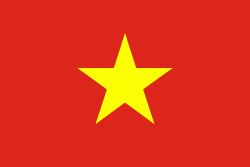Vietnamese language
Vietnamese (tiếng Việt) is an Austroasiatic language originating from Vietnam where it is the national and official language. Vietnamese is spoken natively by over 70 million people, several times as many as the rest of the Austroasiatic family combined. It is the native language of the Vietnamese (Kinh) people, as well as a second language or first language for other ethnic groups in Vietnam. As a result of emigration, Vietnamese speakers are also found in other parts of Southeast Asia, East Asia, North America, Europe, and Australia. Vietnamese has also been officially recognized as a minority language in the Czech Republic.
Like many other languages in Southeast Asia and East Asia, Vietnamese is an analytic language with phonemic tone. It has head-initial directionality, with subject–verb–object order and modifiers following the words they modify. It also uses noun classifiers. Its vocabulary has had significant influence from Chinese and French.
Vietnamese was historically written using Chữ Nôm, a logographic script using Chinese characters (Chữ Hán) to represent Sino-Vietnamese vocabulary and some native Vietnamese words, together with many locally invented characters to represent other words. French colonial rule of Vietnam led to the official adoption of the Vietnamese alphabet (Chữ Quốc ngữ) which is based on Latin script. It uses digraphs and diacritics to mark tones and some phonemes.
Early linguistic work some 150 years ago (Logan 1852 and Schmidt 1905) classified Vietnamese as belonging to the Mon–Khmer branch of the Austroasiatic language family (which also includes the Khmer language spoken in Cambodia, as well as various smaller and/or regional languages, such as the Munda and Khasi languages spoken in eastern India, and others in Laos, southern China and parts of Thailand). Later, Mường was found to be more closely related to Vietnamese than other Mon–Khmer languages, and a Viet–Muong subgrouping was established, also including Thavung, Chut, Cuoi, etc. The term "Vietic" was proposed by Hayes (1992), who proposed to redefine Viet–Muong as referring to a subbranch of Vietic containing only Vietnamese and Mường. The term "Vietic" is used, among others, by Gérard Diffloth, with a slightly different proposal on subclassification, within which the term "Viet–Muong" refers to a lower subgrouping (within an eastern Vietic branch) consisting of Vietnamese dialects, Mường dialects, and Nguồn (of Quảng Bình Province).
Like many other languages in Southeast Asia and East Asia, Vietnamese is an analytic language with phonemic tone. It has head-initial directionality, with subject–verb–object order and modifiers following the words they modify. It also uses noun classifiers. Its vocabulary has had significant influence from Chinese and French.
Vietnamese was historically written using Chữ Nôm, a logographic script using Chinese characters (Chữ Hán) to represent Sino-Vietnamese vocabulary and some native Vietnamese words, together with many locally invented characters to represent other words. French colonial rule of Vietnam led to the official adoption of the Vietnamese alphabet (Chữ Quốc ngữ) which is based on Latin script. It uses digraphs and diacritics to mark tones and some phonemes.
Early linguistic work some 150 years ago (Logan 1852 and Schmidt 1905) classified Vietnamese as belonging to the Mon–Khmer branch of the Austroasiatic language family (which also includes the Khmer language spoken in Cambodia, as well as various smaller and/or regional languages, such as the Munda and Khasi languages spoken in eastern India, and others in Laos, southern China and parts of Thailand). Later, Mường was found to be more closely related to Vietnamese than other Mon–Khmer languages, and a Viet–Muong subgrouping was established, also including Thavung, Chut, Cuoi, etc. The term "Vietic" was proposed by Hayes (1992), who proposed to redefine Viet–Muong as referring to a subbranch of Vietic containing only Vietnamese and Mường. The term "Vietic" is used, among others, by Gérard Diffloth, with a slightly different proposal on subclassification, within which the term "Viet–Muong" refers to a lower subgrouping (within an eastern Vietic branch) consisting of Vietnamese dialects, Mường dialects, and Nguồn (of Quảng Bình Province).
Country
-
Vietnam
Vietnam or Viet Nam (Việt Nam, ), officially the Socialist Republic of Vietnam, is a country in Southeast Asia. It is located at the eastern edge of mainland Southeast Asia, with an area of 311699 km2 and population of 96 million, making it the world's sixteenth-most populous country. Vietnam borders China to the north, and Laos and Cambodia to the west. It shares maritime borders with Thailand through the Gulf of Thailand, and the Philippines, Indonesia, and Malaysia through the South China Sea. Its capital is Hanoi and its largest city is Ho Chi Minh City (informal popular name is Saigon).
Vietnam was inhabited by the Paleolithic age, with states established in the first millennium BC on the Red River Delta in modern-day northern Vietnam. The Han dynasty annexed Northern and Central Vietnam under Chinese rule from 111 BC, until the first dynasty emerged in 939. Successive monarchical dynasties absorbed Chinese influences through Confucianism and Buddhism, and expanded southward to the Mekong Delta, conquering Champa. The Nguyễn—the last imperial dynasty—surrendered to France in 1883. Following the August Revolution, the nationalist Viet Minh under the leadership of communist revolutionary Ho Chi Minh proclaimed independence from France in 1945.
